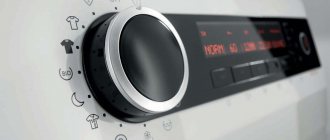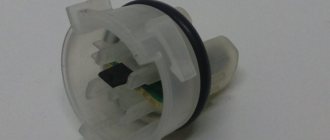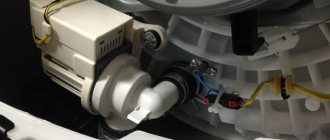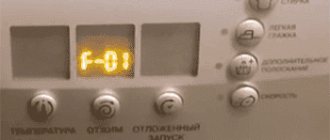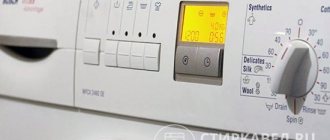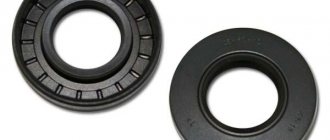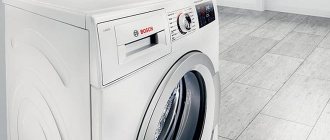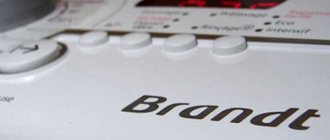The failure of household appliances almost always entails significant financial costs. Especially when it comes to large equipment - a refrigerator, electric oven or washing machine. Calling a technician just to determine the breakdown and identify its causes is usually paid for. And then there is a call for a cargo taxi, delivery of household appliances to the workshop, etc. In this article I will describe the most common washing machine malfunctions, their probable causes, as well as how to fix them yourself.
Regardless of the manufacturer and model, all typical washing machine breakdowns can be summarized in the following list:
- Does not drain water during operation or spinning;
- Does not turn on - the control panel does not light up;
- Does not heat water;
- Leaks;
- During the spin cycle, the program freezes or the function does not work;
- The loading hatch does not open.
Let's look at the listed washing machine malfunctions, their causes and elimination in more detail.
Washing machine won't turn on
Let's look at the problem: the machine won't turn on.
It may not respond to being plugged in at all. The indicators may light up, but the machine does not go into operating mode, the buttons are not active.
Eating problems
The first thing to do is check if the outlet is working. To do this, you can include any known working device in it. Next you should inspect the fork. It may be damaged or broken at the junction with the cord. And it happens that the plug is simply not tightly inserted into the connector. If the machine is connected through a surge protector, you can check it too. If you've looked through everything and haven't found the problem, move on to the next step.
Incorrect inclusion
Perhaps everything is fine with your assistant, but the order in which it was turned on is incorrect. Many machine models have a “child lock” option; it is needed to prevent accidental activation. When you turn on this program, the buttons do not work. Usually, this is some combination of 2-3 buttons that is triggered when pressed simultaneously for a certain time. The indicator of this function or the indicators of the buttons pressed will light up on the front panel (depending on the brand and model of the machine).
Many machines will not turn on if the door lock is not latched. In this case, the indication will light up as usual, but the wash will not start. Perhaps laundry just got caught in the lock. Inspect the lock hook, it may be deformed and this is precisely the problem.
Problems with the control module
If it is not clear why the washing machine does not work (there are no apparent reasons), then with a high degree of probability the control module has failed. The first thing that can be assessed visually is the condition of the board. For example, in top-loading Ardo machines, sometimes a module pops out of its seat. Vibrations can cause this to happen to any other model. Also check to see if the circuit is flooded with water. Externally, you can evaluate the FPS - the network capacitor; it burns most often. Then you can “ring” the remaining elements for operability: input resistors, diode bridge and others. For Samsung machines older than 7-8 years, the sore spot is the step-down transformer.
Leaking
If a puddle forms under the machine during washing, you need to check the following places for leaks:
- Supply hose;
- Loading hatch cuff;
- Pump, filter and drain pipe;
- Tank seal;
- Retractable powder dispenser and water supply tubes.
Inlet hose
Connection points for the inlet hose - you need to tighten the nut more tightly, but without using a wrench.
Drain pump with drain pipe
Leaking from under the bottom of the washing machine. We lay it on its side and check all the connections between the drain pump and the filter and the drain pipe. The clamps need to be tightened more tightly. If the pipe material has lost its elasticity, it is better to replace the part completely. But as a temporary measure, for 1-2 washes, the seat can be lubricated with some kind of sealant, then install the pipe and tighten the clamp.
Tighten the clamps
Very often, during washing, foreign sharp objects fall out of pockets, which can damage the cuff near the hatch. In this case, there is only one way out - simply replace it. The cuff is made of silicone and cannot be repaired.
Cuff damage
Replacing the cuff
This type of malfunction is especially likely in vertical washing machines, since they have a large cuff area.
For a vertical cuff, replacing the cuff is a rather troublesome procedure, but does not require special skills, only accuracy. The plastic retainer that holds the cuff on a metal or plastic body does not provide for the possibility of removal or reuse, so it must be carefully cut off or removed in another way (nippers, pliers).
The cuff itself must have a special profile that is put on the protrusion - the seat, until it stops. When installing, pay special attention to the markers. Both on the cuff and on the body of the washing machine there are arrows, and in the cuff there are additional protrusions for fasteners. They need to be carefully placed in the right places.
Markers must match
When purchasing a spare cuff, make sure that the repair kit includes clips.
The drum does not spin
The drum may simply mechanically jam. This can be checked by moving it from the inside. A jammed drum will remain in place, or will play a little, but not rotate. After removing the housing, look to see if any small objects are stuck between the tank and the drum. In narrow Indesit machines, buttons and “bones” from linen very often fall under the elastic into this space. A bearing that has failed due to wear can also jam the drum. To replace it, you will need to disassemble the tank. The destruction of the bearings is determined visually; replacement will require some effort.
If, after starting the program, you can hear the engine running, but the drum does not spin, it means the transmission belt has come off. If the design provides, then it can be tightened. If this is not possible, as well as in cases where the belt breaks, it must be replaced with a new one. When purchasing this part, it is important to choose one that is identical in geometry (length, number of wedges).
In direct drive machines (mostly represented on the Russian market by the LG brand), the drum is connected directly to the engine. In this case there is no transmission link, the reliability of the design is higher. But if a problem does occur, it is a global one - leaks from the drum go directly into the engine (through the shaft seal), causing a short circuit. In this case, repairs will have to be done by a service center and at great expense.
If the drum in the belt machine does not spin and the sound of the motor is not heard, the motor brushes most likely need to be replaced. You will need to disassemble the engine, remove the burnt brushes, and install new ones in their place.
It is imperative to clean the collector lamellas to ensure good contact. The cause of the breakdown may be a broken motor power cable. Most likely this can happen in places where it is bent. Much less often there are gaps between the control module and the engine itself, when the command to start work simply does not reach the performer.
Call the master
Inexperienced users prefer not to take risks and immediately call a specialist. The price of repairs in services starts from 600-2000 rubles. depending on the cause of the breakdown. The work of an independent specialist will cost 15-20% less. Spare parts and consumables are paid separately.
A few simple recommendations will help you avoid fraud and overpayment
- When choosing a company, pay attention to the number and recency of reviews. If the service center’s website indicates that it has been operating for several years, and on popular sites there are only 2-3 reviews no older than 2-3 months, then this option is unreliable.
- Check the address, phone number and other details of the company through search engines. Unscrupulous craftsmen are often discussed on thematic and local forums.
Check with the operator for the price and conditions for diagnosing SMA. If the service offers free diagnostics without analysis, then you need to take into account that even removing the side cover of the car will oblige the client to pay for the inspection.- If repairs are done at home, pay attention to the tools of the master. If some breakdowns (for example, wear of bearings or belts) can be determined visually, then broken contacts on the control unit or malfunctions of the heating element can only be diagnosed using a tester.
- Do not leave the master alone in the room. A good specialist should explain to the client which part has failed and what is needed to replace it. The list of operations is compared with that indicated in the documents.
- Request receipts for materials and parts, a receipt for repairs and a certificate of completion of work. Each operation is indicated separately in the documents (for example, “Replacing the heating element”, “Cleaning the contacts of the control unit”, etc.). The certificates and receipts are marked with a blue seal of the service and the warranty period for the work is indicated.
If the suspected cause of the problem has been established, you can determine the cost of repairs at the first call. The technician must know the price of spare parts and their installation.
If the call is answered by an operator who does not understand technical nuances, then he must connect the client with a specialist.
A lot of important and useful information about repairing Indesit washing machines is presented in this section.
The water does not heat up during the washing process
Washing in cold water is not the most efficient process. Therefore, if the machine works: it turns on, starts modes, spins the drum, but does not heat the water, this is a reason to work on it.
Most often, with almost 100% probability, the source of this problem is the failure of the heating element (TENA). This may happen for the following reasons:
- hard water causes scale to form on the body of the TEN. On the one hand, this reduces the conductivity of heat, on the other, the destruction of the metal under the layer of salts;
- wear of the part over time (usually the manual indicates the maximum service life of the machine, taking into account the onset of natural wear);
- constant power surges in the network.
To get to this part, for example, in LG and Indesit machines, you need to remove the back wall of the unit. An elongated TEN nest will be visible below the drum. Disconnect all sensors and cables and pull the heater towards you. Sometimes it immediately becomes clear that the part is no longer working. If not, call it with a tester.
In Bosh and Siemens washing machines, the heater is located at the front. First you need to remove the top cover of the machine, dismantle the powder container and the control panel (it is not necessary to disconnect it, just lift it up). Next, you should remove the sealing rubber of the hatch (by removing the clamp from it) and tuck it inside. Unscrew the lock. By removing the lower decorative trim and unscrewing the fasteners under it, you can detach the front panel of the machine. There will be a TEN below the drum.
If the water heater itself is in order, the contacts to it are also in order, and the water during washing is still cold, then you should consider the following options:
- The temperature sensor is faulty. It is located at the end of the TEN.
- The control module does not work, there is no connection with it (broken wiring).
- The machine draws water during the washing process. This happens if the drain hose is not secured, is too low (less than 60 cm from the floor), and water from the drum spontaneously goes down the drain.
How to disassemble the unit with your own hands?
To diagnose the cause of problems and replace parts, you need to disassemble the machine. The list of necessary tools includes:
- screwdriver, set of heads for it;
- set of open-end wrenches;
- pliers;
- multimeter;
- wide basin;
- paper, dry rags;
- liquid VD-40.
SMA with vertical loading is disassembled in the following order:
Disconnect the unit from the power supply and water supply. Move it away from the walls to provide free access to the internal structure.- Place a rag and a basin towards the front of the machine. Remove the panel at the bottom of the unit, turn the round knob located under it. Remove and clean the drain filter.
- Remove the dashboard from the top of the machine. Depending on the model, this will require prying off the panel, bending the latches, or unscrewing several bolts. Move the control board to the side or remove it. Remove the top cover.
- Remove the clamps on the hoses leading to the filling valve. Disconnect the contacts and remove the valve.
- Unscrew the fasteners on the back of the side wall. Slide it in the grooves and remove it. Removing the top and side panels provides free access to the internal parts of the machine.
- Disconnect the wiring from the tank and heating element. Unscrew the central nut, remove the heating element, slightly rocking it in the socket.
- Remove the belt from the pulley. Remove the fasteners and remove the engine.
- To replace the bearings, you will need to remove both side panels of the SMA. It is not necessary to remove the machine drum for this.
- Remove the bolts that hold the drain pump. Disconnect hoses and contacts from it. Turn the pump counterclockwise and pull it out.
To determine the cause of the breakdown, you need to inspect the spare parts and check the electrical contacts with a multimeter. Before disconnecting the contacts, you need to photograph the connection order or mark them with different colors.
The machine door does not open
Quite often on forums the following situation is described: the machine washed, but the door did not unlock. The master was called, but he will not appear soon. You have to regularly move the laundry in a circle so that it does not fade.
This situation with the door can happen for two reasons:
- The machine does not drain the water completely, or for some reason the sensor thinks that the water has not been drained completely and does not release the door.
- The UBL unit (hatch locking device) itself broke down.
The machine does not drain water
If the machine does not drain water from the tank once or constantly after the end of the washing cycle, then the breakdown must first be looked for in the drainage system (valves, filter, pump, drain hose).
First you need to drain all the water from the machine. First, try turning it off for 5-10 minutes, then run the drain program - sometimes this is enough. If that doesn’t work, then you can use gravity: raise the machine higher, and drain the drain hose as low as possible. The water will drain by itself.
The outlet filter must be washed regularly. It gets clogged with lint from fabrics, small objects (buttons) and even socks. Over time, all this also becomes covered with slippery mud, emitting an unpleasant odor. The outlet narrows and the drainage is disrupted. The filter is located on the front of the machine at the bottom right. When unscrewing it, place the container to collect water downwards. Rinse the part and put it back. Check the drain hose for obstruction. It happens that the drain filter does not unscrew due to foreign objects or scale. Then you will have to remove the front panel of the machine and get to the filter from the inside.
If after these manipulations your assistant does not work as it should, then there is a breakdown in the pump or in that part of the control module that is responsible for the pump. In principle, you can change the pump yourself, but you will need some skill and experience.
The door lock is broken
If the lock is jammed, you can try to open it with a fishing line. Insert it at the bottom of the hatch and try to lift the lock hook upward. If this does not work, you will have to remove the lock manually. After removing the top cover of the machine, reach the hook on the inside and open the lock. If the hook is worn out or deformed, it must be replaced, otherwise the problems may recur.
Spin does not work
Such a nuisance can happen due to the fact that the machine simply cannot distribute the laundry evenly throughout the drum. If there is more than what is loaded into it, or the items are too large. Without distributing the laundry, the machine begins to vibrate strongly during the spin cycle, the protection is triggered, and the spin stops. Here you can simply redistribute things around the drum manually, or put them in the spin cycle in parts.
The balance can also be disrupted for technical reasons: bearings or a cross have fallen out. In this case, replacement of damaged parts will be necessary.
If the machine does not drain the water completely, the automatic machine will also not start the spin program.
Spinning may not start because the machine’s drum does not spin for some reason. How to diagnose and solve this problem is described above.
Summing up
The information and step-by-step repair instructions presented in the article are not the ultimate truth. There are many models of washing machines that have their own layout. In this case, the location of parts for repair or replacement must be determined according to the diagram attached to the data sheet. But if you think that you do not have enough skills or knowledge, then it is better to contact a specialist.
If you have troubleshooted any problems with your washing machine yourself, please share your experience in the discussion of the article.
Strong vibration and noise during operation
Noise during operation may appear in the machine if the fastening of the drum itself or its counterweight is loose.
There can be a manufacturing defect - play in some running parts, which is difficult to eliminate outside of a service center. Vibration during operation is also a source of noise, but it is visible to the naked eye. It also happens that the machine literally jumps around the bathroom. The first thing to check is whether the shipping bolts have been removed.
The machine must be clearly leveled. LG direct drive machines are especially sensitive to the horizon. Silicone pads on the legs help a lot. But anti-vibration mats, according to users, are useless.
If the bolts are removed, the machine is level, but there is still vibration, check the shock absorption system (as with noise).
Unpleasant smell from the machine
The first thing you might think is that the machine needs cleaning. Yes, most often this happens. General cleaning will help here: boil the washing machine with a special product or citric acid. Flush the entire drain system using disinfectants. Even with regular maintenance, but with rare use of high-temperature conditions, when using environmental powders, or from soft water, the machine silts up (especially the sealing rubber and the space under it). The smell may be caused by an improperly connected drain hose. If it is located below the water level in the tank (below 30-50 cm from the floor), then there is no natural water sealer, and the smell from the sewer seeps into the machine. In this case, you need to secure the hose higher. Dry and ventilate the machine. After this, the smell usually goes away quickly.
Typical malfunctions of washing machines from different manufacturers
Most manufacturers use patented technologies in the production of their goods and introduce new ideas in pursuit of consumers. As a result, washing machines of a certain brand have specific usage and their own typical faults.
Indesit
The Indesit brand is one of the few that does not provide a protective coating on its heating elements.
Only medium quality stainless steel is used, thereby reducing the cost of the unit. In hard water conditions, such a heating element with an 80% probability becomes overgrown with a thick layer of scale and fails after 4-5 years of operation. There are often malfunctions in the operation of machine programs: they are not executed completely, they are not turned on in the required sequence, some buttons become “dumb”. All these are symptoms of a control module failure. It requires reflashing. The cost of such repairs is often comparable to the cost of a new machine.
Another common problem with narrow machines is bearings. Repairing them at home is difficult, since you have to completely rebuild the drum structure.
LG
The most popular cars of the LG brand are devices with direct drive.
In them, the drum is connected to the engine not by a belt drive, as in other machines, but directly. This significantly increases the reliability of the entire structure; wear of moving parts is minimal. The specific design of the drainage system leads to frequent breakdowns. The tract becomes clogged more often than with other machines. The drain pump does not turn on, the machine displays an error. Considering the frequency of such a breakdown, its code is written in the user manual. Another problem that owners of LG machines often encounter is a malfunction of the sensor and water intake valve. The valve gasket is made of some kind of thin and “weak” rubber. But the sensor freezes and does not send a signal to the control module to fill with water. As a result, the tank overflows, and the drain system is forced to start working. Water drains on its own with constant supply.
Bosch
Cars of this brand have established themselves as the most reliable of the middle class.
The manufacturer focused on stability and ergonomics. The frequency of breakdowns here is not high and their statistics coincide with the average statistics for all brands. If the machine does not heat the water, then, unlike most budget appliances, the problem here may be not only in the heating element, but also in its controller with equal probability.
The cause of malfunctions may be a clogged drain, filters, or a loose transmission belt. All of them can be eliminated at home.
Ariston
These are middle and economy class cars with high reliability. Their breakdowns occur mainly due to the nuances of operation: hard water, insufficient care, and the like. However, there are also typical problems. For example, most users note an unpleasant odor from the rubber seal even after a long time from the start of use. From technical points: strong noise and vibration during operation accelerates wear of moving parts, bearings, and transmissions. Unfortunately, most of the elements of the machine are non-separable; their breakdown requires contacting service.
Electrolux
The weak point of Electrolux machines is the mains power: the power button often sticks, and even more often the network cable becomes shaggy from vibrations, and the contacts are pulled out of it.
To find a breakdown, you should ring the cable with a tester. There is a typical failure in operating programs: the machine skips the rinsing and/or spinning stages. This clearly indicates incorrect operation of the control module. It must be reprogrammed at a service center.
Samsung
Samsung washing machines are distinguished by high-quality assembly and reliable electronics.
The probability of failure of the control module is very low; there are practically no calls to authorized services about this. Most often, heating elements in machines of this brand fail. Of all the breakdowns, this happens in more than half of the cases. I am glad that heating element repair is possible at home.
Among the characteristic disadvantages of Samsung, it is also worth noting the light counterweight, which results in strong vibration during operation. Under such conditions, the belt stretches and sometimes breaks. Repairing it is possible at home, but it is important to choose original parts. The manufacturer installs good bearings, even in such operating conditions they do not break.
The output filter is located inconveniently, behind the housing panel. It is difficult to open, so many users are reluctant to clean it, as a result the drain system becomes clogged and fails.
Another nuance of the drainage system is that the hoses are short and the valves are subject to water hammer from the sewer. There are connections being broken and water being thrown back into the system.
The door glass is thin and has poor thermal insulation. Its geometry is such that small items get stuck between the glass and the seal when washed. According to statistics, breakdowns do not happen to it, but this point must be taken into account for convenience and safety.
© obzorok.ru
Useful tips for troubleshooting
The following troubleshooting tips may not be necessary if you always use the machine correctly. The easiest way to protect electronics is to unplug them. The power plug must be unplugged between washes (or the circuit breaker must be turned off). It is also recommended to shut off the water supply in order to maintain the functionality of the sensors and supply valves for a long time.
When eliminating problems with your own hands, you should never act primitively or rush. There is no need to try to repair the power cable, it is completely replaceable. Before any work, you should disconnect the machine from the network, examine the location of the operation, and select the appropriate tool.
You need to act carefully and carefully. If you are not completely sure of the causes of the breakdown and the ability to eliminate them, it is recommended to call a qualified specialist.

